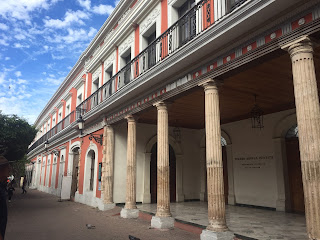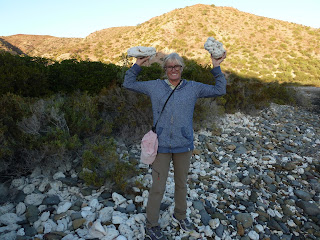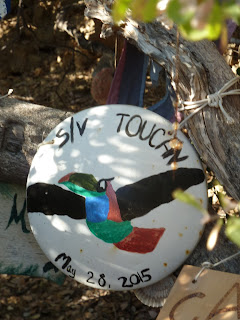Departing the craggy, wild wonders of “l’isle de avion”, in
flat and windless seas, we made for San Blas.
It would have been nice to linger for another day there. But needing to meet Simon and Gavin in PV on
the 30th meant we had some miles to cover, so excessive dillying and
dallying would not compute with our planned rendezvous.
San Blas harbour is an estuary with a bar entrance and we
were dubious about depths in there but thought we would check it out anyway.
The bar proved to have 3-4 feet under our keel, but as we approached the marina
we backed off when we saw maybe 3 inches of keel clearance. Then we tried to
find a spot in the estuary with a little more depth to anchor in. But nudging forward slowly, slowly we
slithered into mud. Enough of that! Backing out again we spun the boat and got
the hell outa there and headed for nearby Matanchen Bay, where we anchored as
the sole bayside visitors.
Christmas eve was a quiet affair. The beach at Matanchen is lined with drive-in
Palapas but as we dinked in towards the shore all but one of the restaurants
were closed or closing. A lone waving
proprietor encouraged us to his establishment and we were able have a quick
dinner. We didn’t linger, as in addition to the gloom of a deserted party
palace this area has a reputation for “Jejenes” which are tiny noseeums that
have a vicious itchy bite and we feared that despite our precautions we were
being secretly eaten. Escaping to the boat
we installed all available bug screens, poured wine and watched a couple
episodes of Game of Thrones.
We expected Christmas day would be more of the same sort of
gloom, but Mexican traditions can surprise.
It turns out that a favourite Mexican Christmas day excursion is to pack
the family vehicle to the gills, drive to the beach, buy fresh-baked goods
along the way and then park under thatch covered parkades (with attached
palapas) for a day party. So our Christmas day afternoon consisted of first partaking
of a dingy landing beer at one of the palapas, then a beach walk past the
Mexican yuletide celebrants and down the road to the “Jungle Tour”. The low-lying shore lands in these parts
create mangrove swamps, and that means perfect wetland habitat.
The jungle tour is by panga boat along a meandering tidal stream:
we passed through long tunnels of mangrove trees that arch above overhead, then
the stream breaks out into areas of estuarial grass, fernland and finally hillside forest. Living all about this wetland jungle are a
large variety of birds, fish, plants and of course, crocodiles. These range in size from teensy weensy salamander
size to 7 meter monsters, though we saw none larger than about 5m. Nevertheless, these were big and creepy and
toothy enough to satisfy all of our croc-viewing needs.
The panga boat ride stops midway at what they call a
crocodile sanctuary, where they carry out some conservation croc breeding. But unfortunately
the sanctuary otherwise has all the characteristics of an old-school zoo, with
depressing little wire and concrete cages for the crocs and similar cages for a
variety of other captive birds, leopards, lynx, etc. It is always interesting for people to be
able to see native animals, but surely it is not so fine for those caged. Continuing
onwards from this dismal zoo, we stopped at a “tourist-Mex” style jungle restaurant
and were served a tasty meal of fried fish.
All in all it was a fun Christmas day spent among the locals.
Still, it must be mentioned that however exotic and wonderful the location, the
passing of a tradition day like Christmas away from home does produce some
longing for the communion of family.
That night as we laid ourselves down we thought enviously of those back
home with their family around the table and with turkey and cranberries on their
plates! At that moment you at home were the
lucky ones…
Christmas at Matanchen Bay.
The ice cream van!
A big one!
Sun sight for fun (we have GPS)!
Boxing Day at Chacala
Crocodile tour up the river at Matanchen.































































































